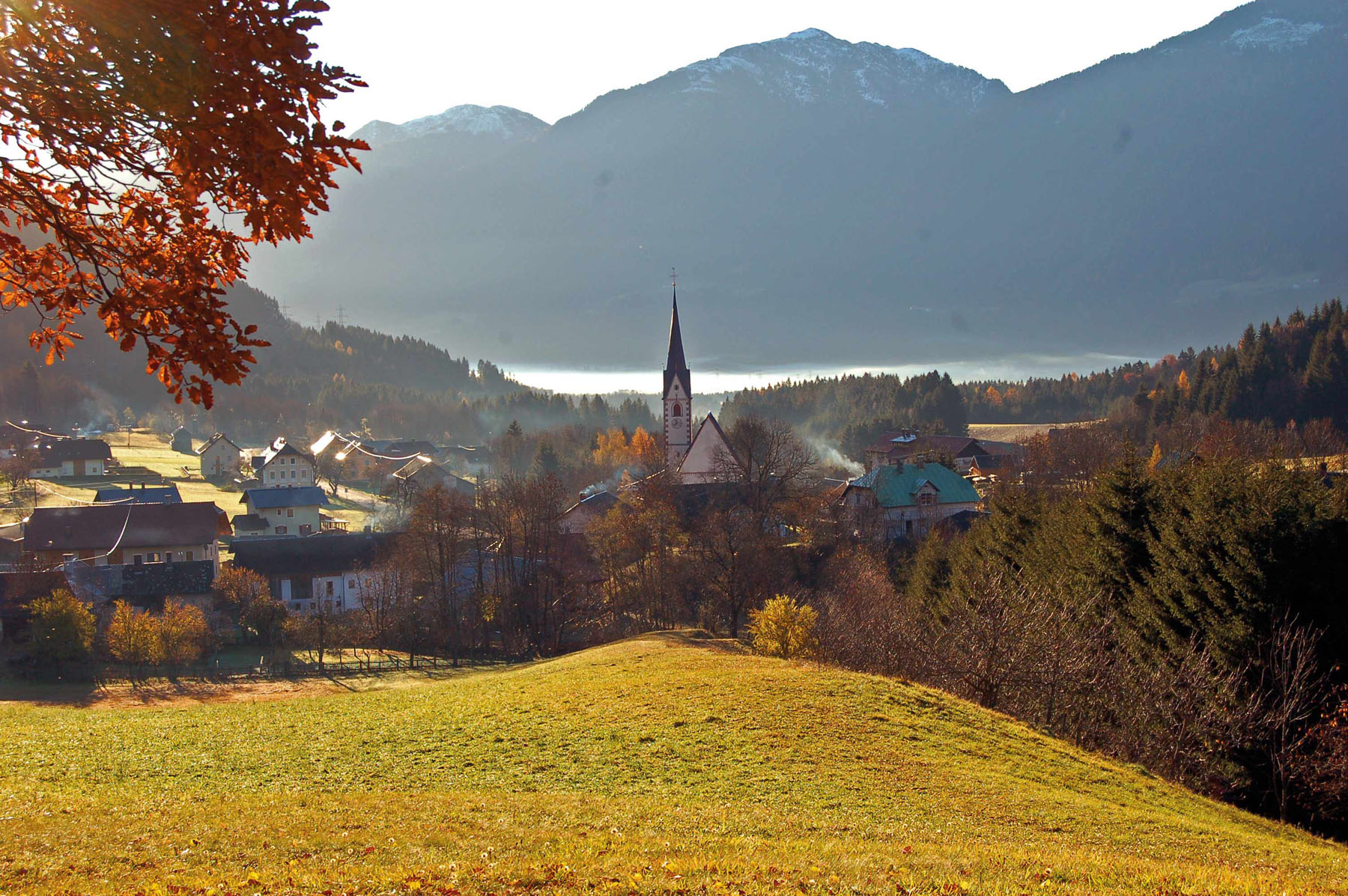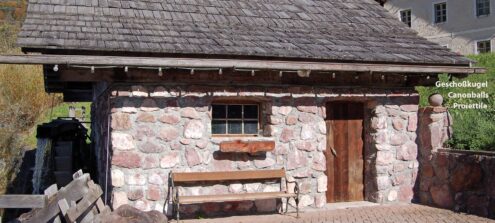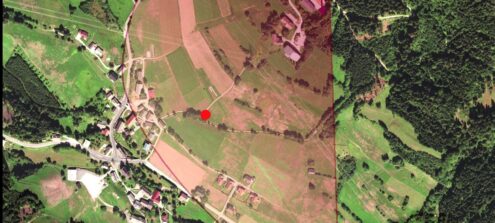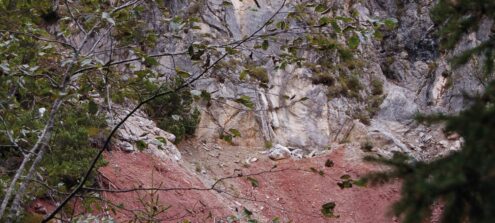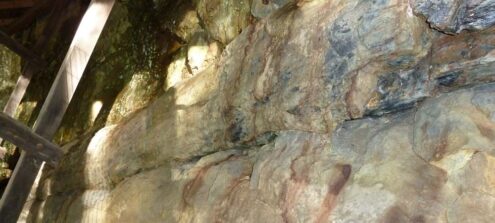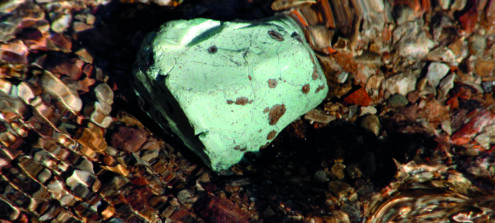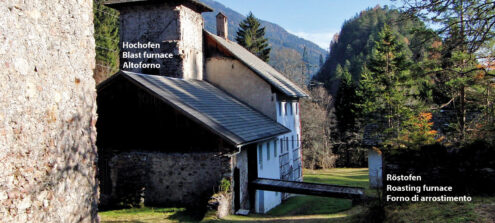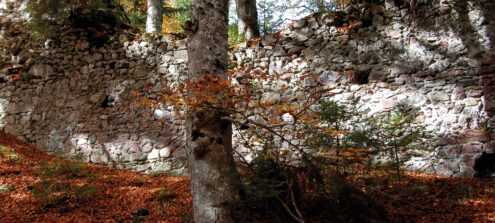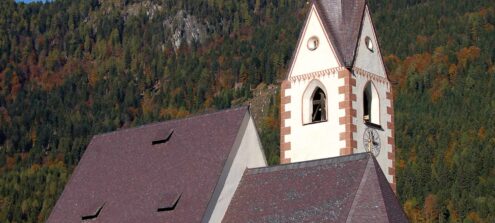Laas - Municipality of Kötschach-Mauthen
Laas Geotrail – A petrified primeval forest – Geology live!
BackAncient fossil trees and the force of water characterize this Geotrail. The petrified tree in Laas is the largest fossilised plant to be found in Austria. As well as good soil, water is essential to the existence of a village. Laas has this in abundance. On the one hand, this is due to its climate, as the Gailtal valley is one of the regions of Carinthia with the highest levels of precipitation. However, the fact that there is spring water of the highest quality here is down to the local geology.
Municipality: Kötschach-Mauthen
Car: via the B110 Plöckenpass Bundesstraße to Laas
Parking: southwest of the church at the fire station
Start of the Geotrail: village fountain at the church
-
1The Laas Mill – a symbol of fertility
In order for a village to develop, two essential foundations of life are required: water and fertile soil. The writing over the door of Laas Mill reminds us of the latter. Soils have a great deal to do with geology because they consist almost entirely of minerals and rocks. In the past, everything people needed to survive was cultivated on the land. This means not only food but also raw material plants such as flax for producing fabrics. Woodland areas provided wood as an indispensable construction material and fuel. Cereals were one of the most important food plants, but had to be ground first to make flour using wear-resistant stones. These stones occur naturally around Laas in the form of red breccias, which are highly resistant due to their quartz content. The mill was not just used to produce flour. Between 1880 and 1930, it people used it to operate threshing and shredding machines at neighbouring farms. The mill is the last in a series of mills, saws and smithies, which were once lined up along the Laas brook.
-
2Mud and debris flows – fear and horror
At first glance, it is not obvious that for the residents of the village the development of this beautiful cultural landscape was linked with fear and horror. Here you are standing on an alluvial fan, a typical landscape feature of valleys. It starts out as a ravine and widens as it runs down the valley to form a fan shape. Over the years, loose stone material accumulates in these ravines and is carried along downstream during heavy rainfall in the form of mud and debris flows. The villages of the Gailtal valley have repeatedly been overrun by these mudflows, for example during 1823 and 1966. Houses were submerged and landscapes were devastated. Cleaning up the fields afterwards was a cumbersome task requiring the removal of gravel and heavy blocks of stone. They were mostly stacked up to form piles of stones or stone walls. In 1878, retaining walls were built just above the apartment buildings at the foot of the mountain to protect Laas and help restrain the mud and debris flows.
-
3The waterworks – plenty of water thanks to a former desert
As well as good soil, water is essential to the existence of a village. Laas has this in abundance. On the one hand, this is due to its climate, as the Gailtal valley is one of the regions of Carinthia with the highest levels of precipitation. However, the fact that there is spring water of the highest quality here is down to the local geology. The peaks of the Gailtal Alps around Laas are mainly composed of limestones and dolomites. The large number of fractures in these rocks means that rainwater drains downward inside the mountain until it reaches less permeable red sedimentary rocks, which were formed when there was a desert-like climate. This barrier layer forces the water to flow out from the mountain. A series of springs are lined up one after another along the whole length of the mountain overlooking the village of Laas. If this barrier layer were not present, the water would continue to flow down inside the mountain and the mountains around Laas would not be such an excellent source of spring water. The first centralised water supply for Laas was built in 1922. The water reservoir bears witness to this. Before this the residents drew their water from a central village or local well.
-
4The petrified trees of Laas – an underestimated treasure
When people are unable to obtain any immediate practical benefit from natural formations, at best they go unnoticed – however valuable they may be to scientists. This is the case of the petrified tree in Laas, the largest fossilised plant to be found in Austria. It was uncovered around 1930 during rock blasting work and initially used by local children as a spectacular playground. It was not discovered by geologists until the 1940s, and it was only in 1968 that it was declared a natural monument. Since then, several other petrified trees have been found in Laas. The first tree mentioned is over 280 million years old and proves that trees of up to 30 m in height grew during the Permian Period. They had widely branching crowns but were not true coniferous trees as we know them today; instead they were their predecessors, cordaites. The scientific name for the tree is Dadoxylon schrollianum. The wood itself has not been preserved; instead the fossil consists of the tree’s pores filled with quartz. The fact that the trees are irregularly distributed in the host rock indicates that they did not grow here, but rather were washed here by torrential water.
-
5Slag stones – turquoise and jade
In the gently babbling brook, gravel ranging from turquoise blue to jade green can be spotted among the red stones. Dark gravel and stones containing voids are even more common, resembling the stones found near volcanoes. They are the first indication along the Geotrail of man’s attempts to use raw materials to make his life easier and more comfortable. In fact, these stones are artificial smelter waste (slag) which was left over when metals were extracted from ore at the nearby blast furnace. The slag stones look like glass because they cool quickly. There is no time for crystals to form, so they solidify to form a smooth (amorphous) mass like glass. The colours of the stones are derived from various metal salts. The bubble-shaped cavities are created by gases which form during the smelting process and become trapped in the slag stones. These slag stones were used in the past and are still used today as insulation and filling materials (e.g. gravel for road construction) as well as in the cement industry.
-
6The blast furnace – glitz and glamour
One of the most important raw materials known to mankind is iron, as this can be used to produce high quality weapons and robust tools. In the past, it was mined in the Gailtal and Carnic Alps and brought affluence to the area. Two excavation sites also operated close to this site. The Laas blast furnace gives us a clear impression of what an early 19th century smelting works looked like, thanks to its good state of preservation. The furnace began operation in 1817 but operations stopped again in 1847 as they were unprofitable. The forester’s lodge and the furnace which towers over everything dominate the site. Behind it extends the impressive coal barn, from which the furnace was filled with ore and charcoal via a wooden bridge. The double roasting furnace, where the ore was desulphurised, is unique in Austria. Each year on average 140 tonnes of pig iron were produced in Laas. The forester’s lodge was even used as a film set in the 1950s. The film crew for the local film ‘Die Försterbuben’ brought a touch of glamour to the agricultural Gailtal valley.
-
7The Pittersburg – an old castle on young rock
Just like everywhere else, people here too had to build wooden and stone buildings to protect themselves against the threats of nature and enemies. By their very nature wooden structures offered less security against enemy attacks, which explains why stone buildings were preferred for fortifications and castles. Of the primary three groups of rocks occurring around Laas (garnet mica schist at the base, limestone on the top and red continental deposits in between), only the last two were used as construction materials and for manufacturing everyday objects. And not just for the castle! They were also used to make house and garden walls, mortars and millstones and even cannonballs for storming the Pittersburg! No use could be found for the mica schist due to its slate-like structure and low level of robustness. The Pittersburg castle was built on a striking limestone ridge. Approximately 245 million years old, it is the youngest rock encountered along the Geotrail. The castle was first documented in 1252. It began to fall into ruins from the 16th century. The ruins of a cistern, keep and outer bailey wall have been preserved.
-
8The village church – something unexpected
Stone art of an unexpectedly high quality can be admired in the late Gothic church of St. Andreas. This cultural achievement was possible on the one hand because there were sufficient funds available to employ skilled craft workers, because over the centuries the Pittersburg castle near Laas was home to some wealthy administrators. They were responsible for having the church built. On the other hand, the materials required for stone masonry were also found on-site: the red Laas sandstone which is easy to process thanks to its fine-grained structure. A church was built here under the direction of Bartlmä Firtaler between 1510 and 1535. The very best quality stonemasonry can be found on the doorway to the sacristy. A Late Gothic lock and fittings have also been preserved on the door itself. The little stone men high above the buttresses decorated with finials on the outer wall are somewhat bizarre in appearance. The stones around the West and South doorways with their Late Gothic iron-clad doors have also been elaborately carved. The stellar and latticed ribbed vault with its delicately painted flowers is part of the special charm of this church.

